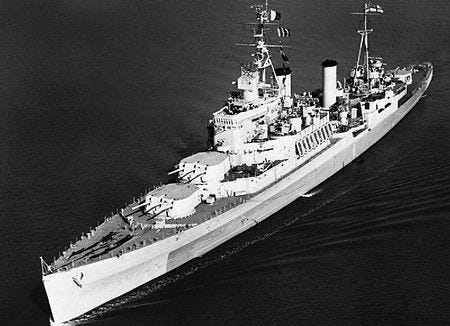In the frightening and existential days of World War II, the British built many warships; two of them were Fiji-class light cruisers, HMShips UGANDA and MINOTAUR. They were slated to have contrasting histories, even though they both eventually sailed in the Royal Canadian Navy. UGANDA commissioned in January 1943, and MINOTAUR followed in April 1945.
Discounting aircraft carriers, these ships were the largest, and certainly the most powerful in terms of firepower, ever to sail under Canadian colours. They boasted three triple-6-inch gun turrets, four twin 4-inch mountings, along with four 40mm and ten 20mm AA armament and torpedo tubes. As originally built they also carried two Supermarine Walrus reconnaissance aircraft.
His Majesty’s Ship UGANDA started her service with the Royal Navy as part of the Home Fleet, seeing Scapa Flow, the Channel, and the Western Approaches. She notably escorted convoys across the Bay of Biscay, where she dodged an attack by German glider bombs.
After a refit the ship proceeded to Gibraltar, where she was slated to take part in the attack on the “soft underbelly” of Europe—which didn’t turn out to be as soft as hoped by the planners in London.
The first step in the crucial plan to take Italy out of the war was to invade Sicily, codename Operation Husky. On July 10th 1943 HMS UGANDA along with six other cruisers and numerous smaller vessels commenced the bombardment of the island’s defences. The action was intense in the midst of the attacking force, which included troop carriers, LST's, and thousands of troops.
UGANDA also helped rescue airborne glider troops who had been released by their towing Dakota too early and thus landed in the sea. Nearby, a hospital ship with Allied and Italian injured on board was bombed and sunk; UGANDA took on many survivors.
UGANDA continued her bombardment of Nazi strongholds on Sicily until August 17th 1943 when the battle for Sicily was over. The Allies, with UGANDA in the centre of the seagoing action, were ready for the next step. The mainland of Italy lay waiting.





As always, very interesting.